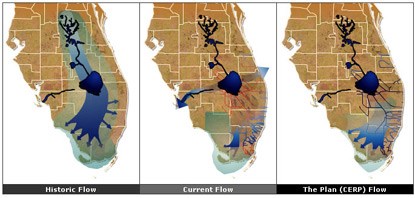
The Comprehensive Everglades Restoration Plan
The manipulation of water in south Florida over the past 100 years has created an environmental crisis today, leading to the near collapse of three nationally-recognized estuaries. The Caloosahatchee and St. Lucie Rivers are inundated with toxic and polluted freshwater from Lake Okeechobee, causing toxic algae blooms, seagrass die-offs, and fish kills while the Everglades and Florida Bay are starved of the natural freshwater flow they desperately need.
CERP was authorized by Congress in 2000 as a plan to “restore, preserve, and protect the south Florida ecosystem while providing for other water-related needs of the region, including water supply and flood protection.” At a cost of more than $10.5 billion and with a 35+ year timeline, this is the largest hydrologic restoration project on the planet.
A unique state and federal partnership guides the interagency plan, including a 50-50 cost share between the two. That means for anything to move forward, advocates are forced to work with myriad agencies and regulatory bodies with completely different processes for each – including ensuring adequate funding levels to get these projects online.
Originally designed to “save the Everglades,” which required roughly 10-12 projects, CERP exploded into 68 projects to appease stakeholders with a different agenda than saving the ecosystem. Most of these taxpayer funded projects will create additional water supply for agriculture, sugarcane, and booming population centers from new development.
True Everglades Restoration
Our efforts center around those projects that work to fix the broken water management system – to halt toxic discharges to the coasts and get clean freshwater flowing again to the Everglades and down to Everglades National Park and Florida Bay, the headwaters of the Florida Keys.

Historical, current and restored flow of freshwater.
The heart of Everglades restoration
On the list of 68 CERP projects, number two is the Everglades Agricultural Area (EAA) Reservoir. The heart of Everglades restoration is reconnecting Lake Okeechobee to the Everglades so ample water can be stored, get cleansed and released to flow south again into the Everglades and down Florida Bay.
As called for in the CERP, the Everglades needs an above-ground reservoir directly south of Lake Okeechobee located in the 500,000 acres of sugar cane fields that make up the Everglades Agricultural Area (EAA). This Everglades reservoir is the most important project we can construct and implement to significantly reduce the amount of freshwater that is currently being discharged east and west.
Everglades Trust supports the 200-plus Everglades scientists who believe that increased storage, treatment, and conveyance of water south of Lake Okeechobee is essential to stop the damaging discharges to the coastal estuaries; to restore the flow of clean, freshwater to Everglades National Park, Florida Bay and the Florida Keys; to improve the health of Lake Okeechobee; and to protect the drinking water for 9 million Floridians living in Monroe, Miami-Dade, Broward and Palm Beach counties, as well as the millions of visitors each year.
The critical dollars to build these project are available from both the federal government and the state of Florida. Everglades restoration is funded annually by the United States Congress via direct appropriation to the U.S. Army Corps of Engineers and the Department of the Interior.
But for years, Florida has not consistently received the levels of federal funding necessary to ensure Everglades Restoration is successful. Finally, due to the tireless work of environmental organizations, advocates, citizens and politicians alike, Congress began to engage in more serious attention and action in 2019. Funding levels have increased significantly, though as of March 20, 2022, the federal government remains roughly $4 billion behind the state’s investment.
